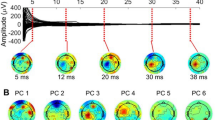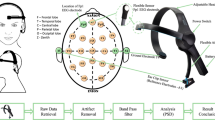Abstract
Surface-recorded somatosensory-evoked potentials (SEPs) are neural signals elicited by an external stimulus. In the case of electrically induced SEPs, the artifact generated by the stimulation process can severely distort the signal. In some cases, the artifact tail often lasts well into the initiation of the SEP making the determination of absolute latency very difficult. In this work, a new approach was taken to identify factors that affect the tail of the artifact. The methodology adopted was the development of a lumped electrical circuit model of the artifact generation process. While the modeling of the instrumentation hardware is relatively simple, this is not the case with tissue and electrode/skin interface effects. Consequently, this paper describes a novel tissue modeling approach that uses an autoregressive moving average (ARMA) parametric technique and an artificial neural network (ANN) to estimate tissue parameters from experimental data. This coupled with an estimation of the stimulation electrode–skin impedance completes the lumped circuit model. Simulink® (The Mathworks Inc.) was used to evaluate the model under several different conditions. These results show that both the stimulation electrode–skin interface impedance and nature of the body tissue directly under the recording electrodes have a profound effect on the appearance of the stimulus artifact tail. This was verified by experimentally recorded data obtained from the median nerve using surface electrodes. Conclusions drawn from this work include that stimulation electrodes with low series capacitance should be used whenever possible to minimize the duration of the artifact tail.











Similar content being viewed by others
Notes
The Math Works, Inc., Nantick, MA, USA
Computer Boards, Inc., Mansfield, MA, USA.
The Math Works, Inc., Nantick, MA, USA.
‘Digital’ referring to their position on the finger and not implying any signal processing.
Medtronic of Canada Ltd, Mississauga, ON, Canada.
References
Anderson VO, Buchthal F (1970) Low noise alternating current amplifier and compensator to reduce stimulus artifact. Med Biol Eng 8:501–508
Babb TL, Mariani E, Strain GM, Lieb JP, Soper HV, Crandall PH (1978) A sample and hold amplifier system for stimulus artifact suppression. Electroencephalogr Clin Neurophysiol 44:528–531
Brown RH, Nash CL, Berilla JA, Amatio MD (1981) Spinal monitoring as an adjunct to spine surgery. In: 34th IEEE annual conference on engineering in medicine and biology, Houston TX, p 308
Del Pozo F, Delgado MR (1978) Hybrid stimulator for chronic experiments. IEEE Trans Biomed Eng 25:92–94
De Luca G, Lovely DF, Parker PA (1997) Real-time cancellation of stimulus artifact in somatosensory evoked potential monitoring. In: 23rd Canadian Medical & Biological Engineering Society (CMBES) conference, Toronto, ON, Canada, pp 28–29
Doraiswami R (1993) Performance monitoring and fault prediction using linear predictive coding algorithm. Automatica 29(4):1115–1120
Freeman JA (1970) An electronic stimulus artifact suppressor. Electroencephalogr Clin Neurophysiol 31:170–172
Golub GH, Pereyra V (1973) The differentiation of pseudo-inverses and nonlinear least-squares problems whose variables separate. SIAM J Numer Anal 10(2):413–432
Grieve R, Parker PA, Hudgins B (1995) Adaptive stimulus artifact cancellation in biological signals using neural networks. In: Annual international conference of the IEEE engineering in medicine and biology—proceedings, vol 17(1), pp 801–802
Hamming N, Lovely DF (2006) Influence of recording instrumentation on the stimulus artifact tail in surface acquisition of somatosensory evoked potentials. Med Eng Phys (in press). DOI 10.1016/j.medengphy.2005.12.004
Harrison SAB, Lovely DF (1995) Identification of noise sources in the surface recording of spinal somatosensory evoked potentials. Med Biol Eng Comput 33:299–305
Knaflitz M, Merletti R (1988) Suppression of stimulation artifacts from myoelectric-evoked potential recordings. IEEE Trans Biomed Eng 35:758–763
Ljung L (1999) System identification: theory for the user, Prentice-Hall information and system science series, ISBN 01-365-66952
Lovely DF (1993) Low noise electrode amplifier for use in evoked potential studies. In: 19th Canadian Medical & Biological Engineering Society (CMBES) conference, Ottawa, ON, Canada, pp 236–237
Mallory GJW, Doraiswami R (1999) A filter for on-line estimation of spectral content. IEEE Trans Instrum Meas 48(6):1047–1055
McGill KC, Cummins KL, Dorfman LJ, Berlizot BB, Luetkemeter K, Nishimura DJ, Widrow B (1982) On the nature and elimination of stimulus artifact in nerve signals evoked and recorded using surface electrodes. IEEE Trans Biomed Eng 29:129–137
Minzly J, Mizrahi J, Hakim N, Liberson A (1993) Stimulus artifact suppressor for EMG recording during FES by a constant-current stimulator. Med Biol Eng Comput 31(1):72–75
Parsa V, Parker PA, Scott RN (1998) Adaptive stimulus artifact reduction in noncortical somatosensory evoked potential studies. IEEE Trans Biomed Eng 45:165–179
Pearson AE (1989) Identifiability and well posedness in nonlinear system I/O modeling. In: Proceedings of the conference on decision and control, Tampa, FL, pp 624–625
Peper A, Grimbergen CA (1983) EEG measurement during electrical stimulation. IEEE Trans Biomed Eng 30:231–233
Roby RJ, Ettore L (1975) A simplified circuit for stimulus artifact suppression. Electroencephalogr Clin Neurophysiol 39:85–87
Ross JE, Parker PA, Lovely DF (2000) Design of a PC controlled constant current stimulator for evoked potential studies. In: Proceedings of the 22nd annual international conference, IEEE Engineering in Medicine Society, vol 4, pp 2594–2596
Scott RN, Mclean L, Parker PA (1997) Stimulus artifact in somatosensory evoked potential measurement. Med Biol Eng Comput 35(3):211–215
Stephens WGS (1963) The current–voltage relationship in human skin. Med Electron Biol Eng 1:389–399
Webster JG (1998) Medical instrumentation: application and design, 3rd edn. Chapter 5: Biopotential electrodes. Wiley, New York, ISBN: 0-471-15368-0
Acknowledgments
The authors would like to acknowledge the financial assistance given to this work by the Natural Sciences and Engineering Research Council of Canada through Discovery Grants 4475 and 1702. The authors would also like to extend sincere appreciation to the students and staff of the Institute of Biomedical Engineering at the University of New Brunswick for their support throughout this work.
Author information
Authors and Affiliations
Corresponding author
Rights and permissions
About this article
Cite this article
Hua, Y., Lovely, D.F. & Doraiswami, R. Factors affecting the stimulus artifact tail in surface-recorded somatosensory-evoked potentials. Med Bio Eng Comput 44, 226–241 (2006). https://doi.org/10.1007/s11517-006-0034-4
Received:
Accepted:
Published:
Issue Date:
DOI: https://doi.org/10.1007/s11517-006-0034-4




